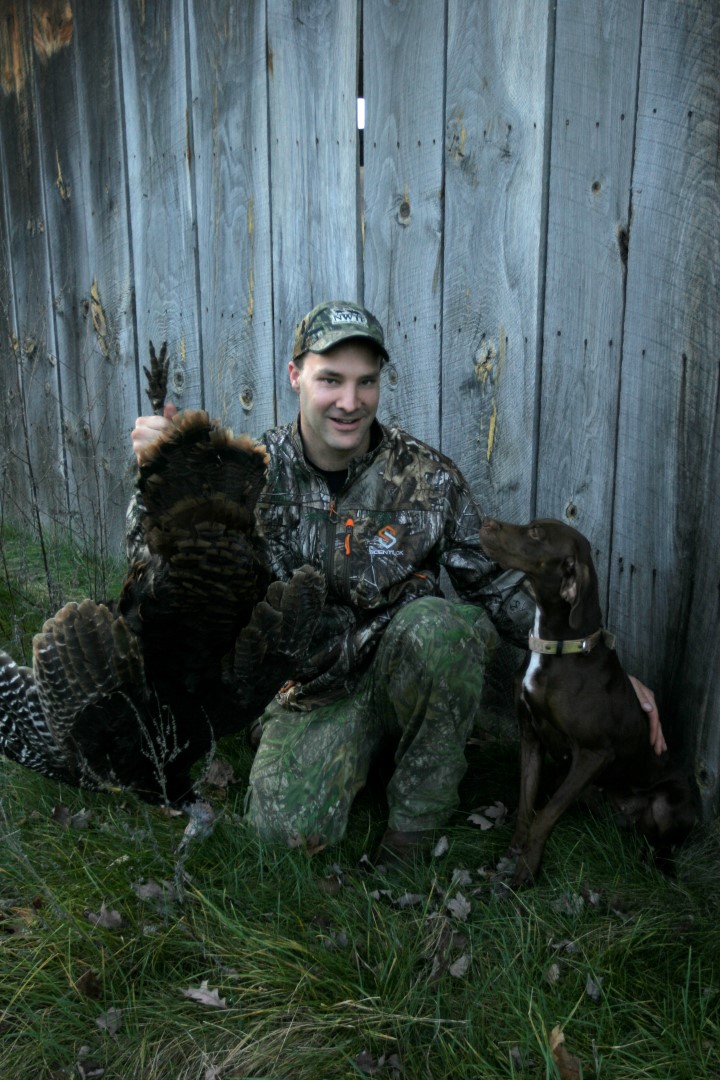by Tracy Breen
When people think about turkey hunting, most think about calling in a strutting tom in the spring. Few people think about tagging a turkey during the latter months of the year. What few turkey hunters know is fall turkey hunting has a longer history than spring hunting. In particular, turkey hunting in the fall with the help of hunting dogs goes back over one hundred years. In those days, turkey hunting with dogs was a gentleman’s sport and often only the wealthy had good turkey dogs. Spring hunting, on the other hand, has only been legal around fifty years or less in most states.
I own two turkey dogs. My dogs are completely enthralled with turkeys and are not a versatile breed. They don’t retrieve ducks; they don’t point upland game. What a turkey dog does well is chase turkeys. What many hunters don’t realize is turkey hunting with dogs is legal here in the fall.

The epicenter of turkey dog breeding is Virginia which is where most turkey dog breeders call home. One of my dogs came from the late John Byrne who developed a line of turkey dogs that is a cross between a coon hound, an English Setter and an English Pointer. The Byrne line of dogs is considered by many to be the best of the best but the truth is almost any bird dog pup can make a great turkey dog if trained properly.
A turkey dog is trained like a coon hound to cover lots of ground to find fresh turkey scent which eventually leads the dog to a flock of turkeys. In a typical day of fall turkey hunting, a dog will cover miles of ground in search of a flock of turkeys. When the dog finds a flock, they run into the middle of the flock barking loudly. Barking gives the hunter the location of the flock and it helps scatter the flock. When a dog runs into the middle of a flock, the turkeys fly and run in all directions.
When a flock of turkeys get separated from each other, the turkeys start calling to each other within a few hours or less and head towards the scatter location to reunite. The goal of the hunter is to sit down at the scatter location and call the lost turkeys into shotgun range. In the fall, either sex is legal for the taking in most states so many hunters shoot hens or young of the year. Some hardcore turkey hunters try to scatter gobbler flocks only. Many old time turkey hunters consider a fall gobbler called to the gun a much greater trophy than a spring gobbler.
A fall gobbler is often call shy, quiet and sneaky. After they have been separated from their buddies, they don’t come running to the gun like a spring tom. In fact, many serious fall hunters say you can plan to wait for hours or even a full day after a flock has been scattered before a tom comes back in. Patience is necessary when hunting fall gobblers. Keep in mind that in some cases, fall gobblers come gobbling and strutting in just like a spring tom to find their buddies and establish a pecking order.
Many will ask me how to train a dog to hunt turkeys? Like any hunting dog, it starts with laying a good foundation. “Within weeks of bringing a puppy home, I start hiding turkey wings for the puppy to find,” says Brett Berry, a pro staff member for Zink Game Calls who owns three turkey dogs. “Like any hunting dog, you continually train them on the thing you want them to hunt. In this case, it is turkeys.” When fall arrives Berry hunts weekly to ensure the puppy gets lot of hunting experience.
Berry trains his dogs to climb into a duffel bag after a flock has been busted. The dog lays motionless in the bag until the gun goes off.
Fall turkey hunting with dogs requires a good hunting dog, decent calling ability and good woodsman skills. In the fall, a turkey isn’t letting you know where they are. They must be found. Knowing where birds roost, what their food sources are and the typical daily patterns of turkeys help put a bird on the ground.
When a well trained turkey dog hits the woods, it is like telling kids it is okay to open their Christmas presents. They go crazy. Nothing beats the sound of a dog barking in the fall woods followed by the sound of turkey wings.
Over the past 8 or 9 years I have killed many birds in the fall with my dogs. It is far more rewarding for me than spring turkey hunting. One of the greatest perks of fall turkey hunting is rarely will you find another turkey hunter in the woods. I typically hunt from mid morning until mid afternoon, that way I rarely bump into deer hunters.
If you’ve never tried fall turkey, you’re really missing out. And when you hunt them with dogs, it’s simply hard to beat. Fall and winter turkey hunting with a dog is without a doubt some of the most exciting turkey hunting of the year.
Note on Keeping Your Dog Hydrated
When turkey hunting in the fall I keep a GPS unit on my dogs that way I know at all times where the dogs are. One thing I have learned over the years is that for every mile I walk, my dogs run 3 or 4 miles. Because of this I make sure my dogs are always hydrated. Dehydration can cause a lot of health problems for a dog including death. If you looking for a way to keep a dog hydrated check out K9Athlete by Wilderness Athlete. K9Athlete offers Hydrate & Recover which is a powder you put in a dogs water that helps keep them hydrated. It is packed with vitamins and electrolytes. Learn more at www.wildernessathlete.com.